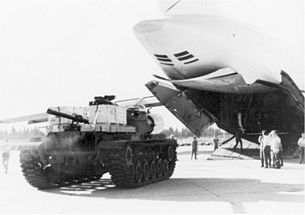| Raising the Flag of Israel in front of the newly formed Israeli Defense Force; April, 1948 |
Six Day War and Yom Kippur War
The history of Israel itself is a long and complex one that requires years and years of study just to understand the last 80 years of it. Despite this, the modern state of Israel has been born in war and conflict. The idea of the Israeli state was finalized in 1917, following WW1, and finally realized after WW2 during which over six million European Jews were exterminated. Its official independence was won in its Arab-Israeli War of 1948 and Israel has continued to face aggressive neighbors up to the modern day. Regardless, two major wars in Israeli history represented huge changes in America's relationship with Israel.
Following the upheavals in Arabic countries surrounding Israel after their rapid victory in the Six Day War, the United States began to pay more attention. The French cut military aid to Israel in an attempt to gain friendlier relations with the Arabs at the same time that Syria and Egypt allowed Soviet military bases and the pro-Soviet coups in Iraq took power. All of these occurring so rapidly drew the attention from the United States who saw Soviet power projection in these new nations and began to move to increase relations with the only pro-Western liberal democracy in the region, Israel. President Johnson was at the head of this effort and planted the seeds of one of the modern world's strongest alliances.
 |
| Operation Nickel Grass |
| Camp David Accords 1978 |
Late Cold War and Post Cold War Israel and Palestine
The United States continued its massive support for the State of Israel and the existence of Israel was more firmly secured than ever before. President Reagan urged Israel to resolve the Palestine issue which had been at the heart of every major war thus far. Israel continued to have problems with Palestinian uprisings as well as terrorist attacks from HAMAS and Hezbollah, two terrorist proxies working to take down Israel.
“President Reagan's chief spokesman today called on both sides involved in the violent protests in Israeli-occupied West Bank and Gaza Strip ‘to step back from confrontation,’ which he said is damaging ‘the self respect and world opinion of the Israeli people.' He said the effect of the occupation ‘also damages the self-respect and world opinion of the Israeli people.’”After the 1979 Revolution in Iran, tensions between Iran and Israel grew markedly worse with both sides threatening war and pre-emptive attacks. Recent American actions such as President Obama's Iran Deal have driven some to believe that the United States has driven Israel away and towards Saudi Arabia, but this is not entirely true. The Israelis still enjoy one of the United States highest priorities and strongest alliances. Actions often speak more than words and while Benjamin Netanyahu may decry American deals, joint military projects and bilateral trade between the two nations speaks to the contrary and demonstrate how strong the United States-Israel relationship is (being one of the few issues that receives bilateral support in the US Congress with 83 senators recently supporting a military aid increase to Israel).
| IDF bombings of Gaza Strip 2014 |
| Rockets fired from Gaza Strip into Israel 2014 |
There is a long time yet to go for the future of the United States and Israel, especially regarding the ever shifting political arena in the region, but one thing is certain, the strength and power of the US-Israel relationship will not be disappearing anytime soon. It is a prosperous alliance, but by no means a perfect one, and each successive crisis will always show the true nature of the United States-Israel relationship.
| Prime Minister Netanyahu of Israel with President Obama of the United States |
Works Cited
"The 1967 Arab-Israeli War - 1961–1968 - Milestones - Office of the Historian." Office of the Historian. U.S. Department of State, n.d. Web. 27 Apr. 2016.
"The Arab-Israeli War of 1948 - 1945–1952 - Milestones - Office of the Historian." Office of the Historian. U.S. Department of State, n.d. Web. 27 Apr. 2016.
Barber, Glen. "Israel's History in Pictures." The Israel Forever Foundation. The Israel Forever Foundation, n.d. Web. 27 Apr. 2016.
Camp David Accords. 1978. Turner. Web. 26 Apr. 2016.
Camp David Accords. 1978. Turner. Web. 26 Apr. 2016.
"Creation of Israel, 1948 - 1945–1952 - Milestones - Office of the Historian." Office of the Historian. United States Department of State, n.d. Web. 27 Apr. 2016.
Friedman, George. "The Complex History of the U.S.-Israel Relationship." RealClearWorld. N.p., n.d. Web. 27 Apr. 2016.
IDF Bombing. N.d. Indiatoday. Web. 26 Apr. 2016.
N.d. International Business Times. Web. 26 Apr. 2016.
Netanyahu and Obama. N.d. Cherson and Molschky. Web. 26 Apr. 2016.
Nickle Grass M60 C-5. 1972. Wikipedia. Web. 27 Apr. 2016.
"Response To Common Inaccuracy: US Gives Israel Too Much Aid." ADL. N.p., n.d. Web. 27 Apr. 2016.
Scheindlin, Dahlia. "Israel's Argument for War against Palestine Ignores the Context | Dahlia Scheindlin." The Guardian. Guardian News and Media, 26 July 2014. Web. 27 Apr. 2016.
Smith, Ben. "Would Reagan Have Passed the GOP's Israel Test?" POLITICO. N.p., 13 Dec. 2011. Web. 27 Apr. 2016.
United States of America. National Security Agency. Office of the Archive. NSA Archive. United States National Security Agency, 18 Oct. 2000. Web. 26 Apr. 2016.
"U.S. Relations With Israel." U.S. Department of State. U.S. Department of State, 10 Mar. 2014. Web. 27 Apr. 2016.
Zanotti, Jim. Israel: Background and U.S. Relations. Rep. Congressional Research Service, 1 June 2015. Web. 26 Apr. 2016.
In your post, you talk a lot about the sheer amount of aid that the US is giving Israel, because it is one of the only pro-Western democracies in the Middle East. But what was the public opinion towards the US helping Israel after World War II? Were people supportive of the government's efforts, or were they against the policies of interventionism/containment?
ReplyDelete